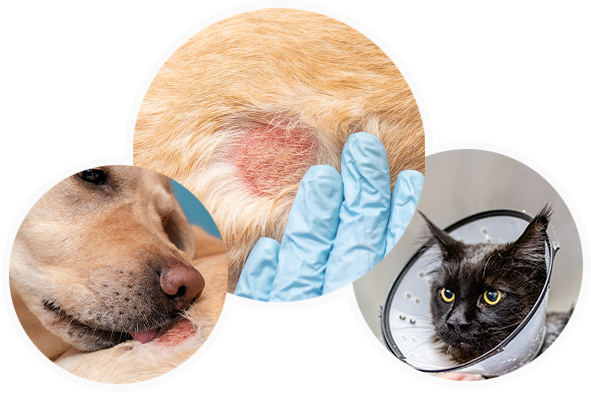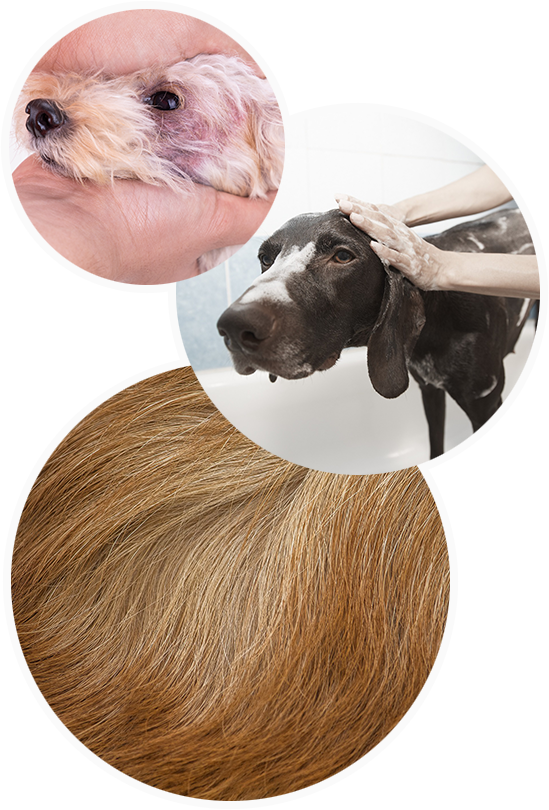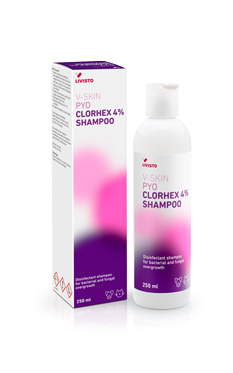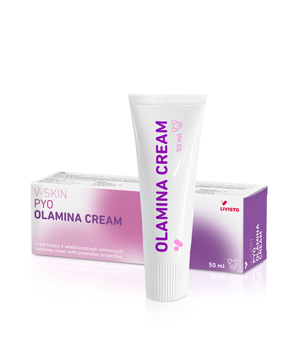Skin infections in dogs and cats
Skin infections in pets are caused
by infectious organisms
Bacterial skin infections in dogs and cats (pyoderma)
Sometimes, when the skin has become damaged due to chronic exposure to moisture, the normal skin bacteria have been altered or changed, or the immune system has been suppressed, a bacterial overgrowth can develop and lead to infection in your pet’s skin. Bacterial skin infections in dogs and cats occurs when the skin’s surface has been broken for any of the reasons mentioned, and they can be mild to severe, very painful and itchy.

The most common bacteria causing infection in a pet’s skin are Staphylococcus spp. Pyoderma is common in dogs and less common in cats.
It is often, but not always, secondary to allergic dermatitis. Most atopic dogs are prone to recurrent superficial pyoderma and papules, pustules, collarettes, pus, a bad smell, scale and seborrhoea are commonly seen. If allergies are the underlying cause, they need to be treated to achieve a complete cure and prevent relapses.
For the treatment of a skin infection, your pet may need antibiotics, as well as topical treatment, which includes sprays and shampoos with chlorhexidine and other substances.Treatment can sometimes can be long term and you will need to be consistent and compliant with the treatment.
It is essential to visit your veterinarian and she/he will decide if you need a prescription for antibiotics or, on the contrary, topical treatment is sufficient.
Ringworm in dogs and cats (dermatophytosis):
Ringworm in pets is a dermatological fungal infection, mostly seen in cats but that canalso affect dogs . It is caused mainly by Microsporum canis. It should be diagnosed and treated as early as possible. It is a very important disease as it is both contagious and zoonotic (can be passed to humans). The fungal infection appears as hairless crusty, circular patches and is often found on the head, paws, ears and front legs of pets.
Your pet’s skin can also appear inflamed and red where it has irritated the area by scratching. Infection is more likely to develop in very young, geriatric, or stressed animals and is quite common in shelter or stray cats, because fungi are opportunistic pathogens that invade the body if there is failure of the host´s innate immune defence systems.
Treatment may be topical, systemic with tablets or both, but isolation of the affected animal during treatment is generally recommended.
Your vet will decide which is the best solution for your pet.

Yeast infections in dogs and cats (Malassezia)
Malassezia pachydermatis is a normal inhabitant of healthy canine and feline skin.
Yeasts live in balance with your pet, but their abnormal overgrowth can cause dermatitis or inflammation of the skin. Warmer areas of the body are prone to yeast infections, that normally develop in areas such as the ear canal, between the toes, groin and perineum. With a yeast infection, the skin can thicken, change colour and tends to smell unpleasant.
Control of yeast infections in pets can be achieved by regular use of topical therapy such as shampoos and sprays, but your pet may also need oral medication.Yeast infections are most frequently associated with allergic skin disease or seborrhoeic skin, and the underlying cause must be treated in order to manage this condition. It is not contagious to other animals or humans.
V-SKIN product that can help you

V-SKIN
PYO
Clorhex 4% shampoo



 We use cookies on our website to give you the most relevant experience by remembering your preferences and repeat visits. By clicking “Accept”, you consent to the use of ALL the cookies. However you may visit Cookie Settings to provide a controlled consent.
We use cookies on our website to give you the most relevant experience by remembering your preferences and repeat visits. By clicking “Accept”, you consent to the use of ALL the cookies. However you may visit Cookie Settings to provide a controlled consent.